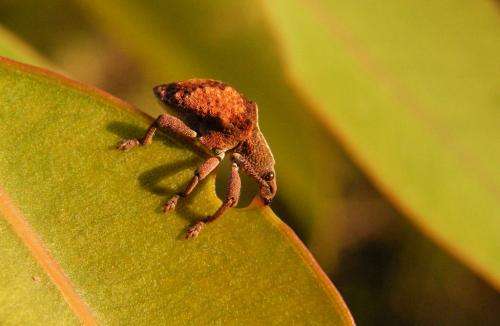Insect and plant communities display surprising endurance against heat

(Phys.org) —A study that transplanted a selection of Australian native plant species to a warmer climate has discovered that although changing environmental conditions impacts individual insect species, their communal roles will survive the heat.
Macquarie University researcher Dr Sabine Nooten and colleagues carried out a multispecies transplant experiment in coastal southeast Australia to investigate the potential effects of a warmer climate on the species composition of insect communities and their structure.
"Transplant experiments are rarely used as they are time and labour intensive, but they are very powerful tools to study climate change impacts because they offer the most direct way to test what might happen in the future," said Dr Nooten.
"We moved plants into a warmer climate – one that these plants will probably experience within their current location during the next few decades, and then investigated the colonisation of the plants by insects under natural conditions."
Eight Australian plant species were transplanted into sites 600 kilometers closer to the equator, and 2.5ºC warmer (mean annual temperature) than the plants' native range. As a control, plants were also transplanted into the centre of the plants' native range. The insect colonisation of all these plants was then monitored for one year.
The researchers from Macquarie University, with Associate Professor Nigel Andrew from the University of New England, found that the composition of the community, in terms of the identity of the species, is dramatically changed in the warmer climate. That is, most of the insects colonising the transplanted plants in the warmer climate were different species to those that use the plant in its current range. Despite this, they found that the range of ecological roles performed by the new species was very similar to those of the original communities.
"Leaf chewing insects were replaced by leaf chewers, sap sucking insects by sap sucking insects, predators by predators, and so on," said Dr Nooten.
"Our results suggest that as the climate warms, most species may be progressively replaced by others, but the distribution of feeding types may retain some elements of their present-day structure.
"The high level of consistency in the insect community suggests that as insects migrate to track climate change, they may colonise new host plants by replacing species with the same foraging function."
The findings, published in the journal PLOS ONE ("Potential impacts of climate change on insect communities: a transplant experiment" Nooten, Andrew and Hughes), are relevant to understanding of community level responses to climate change.
More information: Nooten SS, Andrew NR, Hughes L (2014) "Potential Impacts of Climate Change on Insect Communities: A Transplant Experiment." PLoS ONE 9(1): e85987. DOI: 10.1371/journal.pone.0085987
Journal information: PLoS ONE
Provided by Macquarie University




















